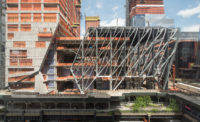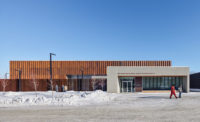Brooklyn, New York
Garbage is a big part of life in New York: the metropolis generates 11,000 tons of waste every 24 hours. From receptacles to bags to trucks, trash is part of the tableau of almost every street on any given day. What it is, how much there is, and where it goes is becoming an increasingly big business—one that not only affects the economy but also quality of life.
But tax savings alone don't win the hearts of New Yorkers who might have to live next to a sanitation facility. After an 11-acre city-owned pier in Sunset Park, Brooklyn—the former site of a New York Police Department vehicle impoundment lot—was chosen, outcries from local community groups were heeded. The $110 million investment in building a new recycling plant had to work for the neighborhood's residents, not just the city infrastructure. So in 2009, Sims and three city agencies—the New York City Economic Development Corporation, and the Departments of Sanitation and Small Business Services—hired Selldorf Architects, a firm headed by Annabelle Selldorf, known for creating beautifully spare galleries and residences, to design the master plan and buildings.
Walking through the Sunset Park Material Recovery Facility feels like an experience designed for people rather than for a truck full of yogurt containers. While the architects organized the site plan around operational requirements, they also devised a series of courtyards and hierarchical volumes that lend a walkable, urban scale to the place. Three big boxlike structures, made of steel with a high-recycled content, house a tipping facility (the building where the majority of inbound material arrives by barge), a sorting and processing plant, and a warehouse to store the resulting bales before they are shipped out by truck or freight rail. Pushed to the southern edge of the pier, these functional spaces are arranged to make room for a crucial element to the north, a Recycling Education Center that contains a cafeteria and Sims's administrative offices. The center is flanked on two sides by landscaped grounds and bioswales, providing occupants access to a verdant waterfront in good weather. Large windows and a second-floor terrace show off the sparkling panorama of the Manhattan skyline and a glimpse of the Statue of Liberty in the distance.
The center is open to the public and will host conservation-themed exhibitions designed by the multidisciplinary studio Whirlwind Creative, and educational events for schoolchildren and adults. Employees and visitors can arrive by car, bike, or on foot along an allée, away from truck and future rail deliveries. “When the places that are necessary to make the city function become more humane and considerate spaces, that changes the city, and the spirit in the city,” says Selldorf.
The team worked with Parks Department landscape designer Mark Vaccaro to develop the green spaces, one of the largest being a placeholder for future expansion on the east side of the property. Early on, Sims presciently raised the site 4 feet using recycled glass and crushed rock from New York's Second Avenue subway excavation as landfill, placing the structures (still under construction) out of Hurricane Sandy's reach in 2012 and above the water level shown on FEMA's 100-year-flood map.
Groups approach the tipping building and its mountain of freshly dumped recyclables along a 70-foot-long bridge leading from the education center. The new facility will inspire visitors by its behind-the-scenes industrial grittiness. But the buildings' forms have an elegant efficiency, especially the gently sloping roof of the tipping building, which shelters barge deliveries and creates clerestories around the perimeter. These openings, along with skylights that pierce the ceiling, let sunlight stream over the procession of conveyor belts and into the adjacent sorting shed.
“Our job was to organize things around the requirements,” says Selldorf. The building was designed to be inexpensive as well as efficient, but its details transform the whole. Cladding with a finely corrugated profile breaks down the mass of the industrial buildings, its anodized finish, uniform throughout, reflecting light in a gentle way. Again, the human experience is foremost; in the noisy space, visual calm creates order. For the tipping building, Selldorf flipped structural elements inside out, revealing delicate tendons of structural cross-bracing between trunk-like steel columns. The gesture is simple, yet produces a carefully considered drama. This is, after all, a building where nothing is wasted.
PeopleClient: Sims Municipal Recycling Owner: Sims Municipal Recycling (buildings), City of New York (land)
Architect:
Personnel in architect's firm who should receive special credit:
Architect of Record (Processing Facility Buildings): Steven Gambino Architects
General contractor:
Photographer(s): Size: 125,000 square feet Cost: $110 million Completion date: December 2013 |
Products
Processing Buildings:
Visitor and Administration Building:
Other products that contribute to sustainability: |













Post a comment to this article
Report Abusive Comment